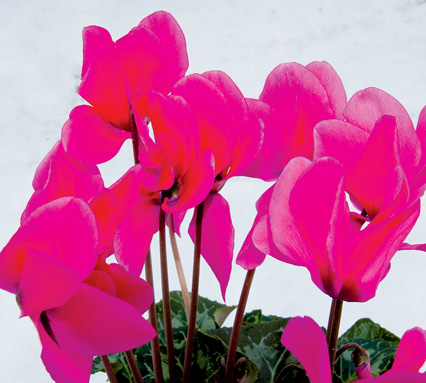The cyclamen is Cupid’s flowering love child.
For centuries, cyclamens have been associated with matters of the heart, making it a perfect Valentine’s Day choice, said University of Missouri Extension horticulturist David Trinklein.
Cultivars of this flowering houseplant bear heart-shaped leaves and fragrant red, pink, white or bicolored flowers. The flower of cyclamen has petals that flare backward and resemble a shooting star, said Trinklein. Most cultivars have silver or grayish-white variegation on the upper surface of their leaves, offering added ornamental interest.
Cyclamen’s history is rich with lore. Greeks used the cyclamen to prepare an amorous food that made the person who ate it fall madly in love. If that was not enough, it received credit for speeding the delivery of babies and curing baldness.

Unfortunately, cyclamen’s tubers contain toxic compounds called saponins that lead to violent diarrhea, convulsions and paralysis in humans. If eaten raw and in large quantities, it could kill a “budding” romance.
Cyclamens are perennials in their natural habitat, which ranges from Europe and the Mediterranean region eastward toward Iran. They are a cool-loving plant.
If cyclamen is on your gift-giving list for your significant other this Valentine’s Day, choose plants with a multitude of buds in the center of the plant. Discolored leaf margins indicate root problems, said Trinklein.
Cyclamens bloom for several months if kept in a cool but brightly lit spot. Nighttime temperatures near the 50s are best, although they tolerate a range of 50-60 degrees. Daytime temperatures of 70 degrees or less do best. Higher temperatures cause the flower buds to abort. Do not place cyclamen near a heat register or hot air duct.
Do not allow a cyclamen to wilt, said Trinklein. Water uniformly for best results. Too much water causes yellow leaves, collapsing of buds and small flowers.
The perennial flower can be forced to bloom a second year. To rebloom a cyclamen, force it into dormancy by gradually withholding water until the foliage dies back. Do not water for six to eight weeks. Begin watering the plant again by midsummer.
If tubers get too large, repot using a soilless growing medium such as a blend of peat, vermiculite and perlite. Keep half of the tuber above the soil line when repotting. Then move it outside to a cool spot or into a shaded window. As leaves develop, resume normal watering and fertilization, and move the plant to a sunnier location. Keep the growing medium moist at all times. Feed with a houseplant fertilizer according to label instructions. Move the plant inside by fall. It should bloom again by midwinter.
Mites often infect cyclamen, causing the leaves to curl and become stunted. Insecticides are available to treat the mites, but control is difficult. Trinklein suggests discarding mite-infested plants.



Facebook Comments